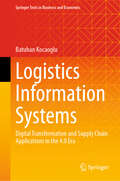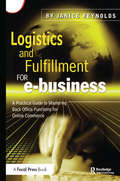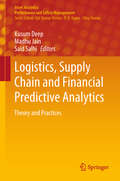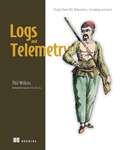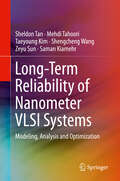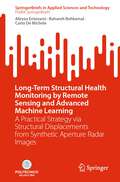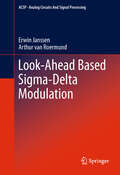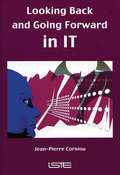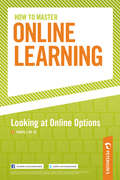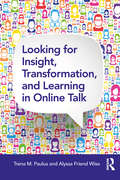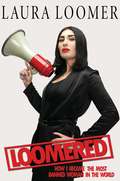- Table View
- List View
Logistics Information Systems: Digital Transformation and Supply Chain Applications in the 4.0 Era (Springer Texts in Business and Economics)
by Batuhan KocaogluIn today’s era of digital transformation, the logistics sector is one of the most technology-intensive industries. This book provides a comprehensive overview of the IT infrastructure required for company operations, the types of enterprise software used in logistics, and current data collection technologies. It addresses the terminology, information flows, and application contexts of the necessary software, helping readers to see the big picture without being overwhelmed by technical details. It explains principal methodologies for modelling and designing systems and describes the objectives of project management and system analysis, not to mention why they are so essential to developing information systems. It also defines critical terms before turning to sector-specific hardware and software solutions for logistics operations: data collection, data processing, and data analytics solutions. In addition, the book includes sections that introduce readers to programming and the core of the database, piquing their interest and guiding them to a higher level of specialization. Study questions are provided at the end of each chapter to test reader comprehension. This book will be a helpful resource for students in logistics or professionals working in the fields of business administration, foreign trade, industrial engineering, ERP, or MIS who want to advance their knowledge and skills in the logistics industry.
Logistics and Fulfillment for e-business: A Practical Guide to Mastering Back Office Functions for Online Commerce
by Janice ReynoldsLogistics and fulfillment management is unglamorous, complex and expensive, but it is one of the primary factors determining whether an e-business will be profitable. Many enterprises (large and small) rush into the e-business model without adequate consi
Logistics and Supply Chain Management: 7th International Conference, LSCM 2020, Tehran, Iran, December 23-24, 2020, Revised Selected Papers (Communications in Computer and Information Science #1458)
by Gerhard-Wilhelm Weber Zohreh Molamohamadi Erfan Babaee Tirkolaee Abolfazl MirzazadehThis book constitutes selected and revised papers from the 7th International Conference Logistics and Supply Chain Management, held in December 2020 in Tehran, Iran. Due to the COVID-19 pandemic the conference was held online. The 17 full papers and 2 short papers pressented were thoroughly reviewed and selected out of 70 submissions. The papers are organized in the topical sections on information technology in supply chain management; production/scheduling and transportation in supply chain management; sustainable and resilient supply chain management; humanitarian supply chain management.
Logistics, Supply Chain and Financial Predictive Analytics: Theory And Practices (Asset Analytics)
by Kusum Deep Madhu Jain Said SalhiThis book addresses a broad range of problems commonly encountered in the fields of financial analysis, logistics and supply chain management, such as the use of big data analytics in the banking sector. Divided into twenty chapters, some of the contemporary topics discussed in the book are co-operative/non-cooperative supply chain models for imperfect quality items with trade-credit financing; a non-dominated sorting water cycle algorithm for the cardinality constrained portfolio problem; and determining initial, basic and feasible solutions for transportation problems by means of the “supply demand reparation method” and “continuous allocation method.” In addition, the book delves into a comparison study on exponential smoothing and the Arima model for fuel prices; optimal policy for Weibull distributed deteriorating items varying with ramp type demand rate and shortages; an inventory model with shortages and deterioration for three different demand rates; outlier labeling methods for medical data; a garbage disposal plant as a validated model of a fault-tolerant system; and the design of a “least cost ration formulation application for cattle”; a preservation technology model for deteriorating items with advertisement dependent demand and trade credit; a time series model for stock price forecasting in India; and asset pricing using capital market curves. The book offers a valuable asset for all researchers and industry practitioners working in these areas, giving them a feel for the latest developments and encouraging them to pursue further research in this direction.
Logistische Netzwerke
by Wolf-Rüdiger BretzkeDer Autor stellt industriespezifische und branchenübergreifende logistische Designprinzipien für erfolgreiche Netzmodelle in den Bereichen Industrie, Handel und Transportdienstleistung vor. Für die 2. Auflage wurde u. a. die Analyse zum Thema Nachhaltigkeit vertieft, der Autor hat außerdem mit zusätzlichen Fallbeispielen und Schaubildern die Verständlichkeit verbessert und widmet den methodologischen Grundlagen jetzt ein eigenes Kapitel. Dadurch werden Wissenschaft und Praxis noch stärker miteinander verzahnt.
Logistische Netzwerke
by Wolf-Rüdiger BretzkeDie 4. Auflage dieses erfolgreichen Buches wurde vollständig neu bearbeitet. Themen wie Netzwerkmanagement und -konfiguration, Servicedesign, Multi-Channel-Logistik und Outsourcing werden behandelt. Besonders erwähnenswert sind die ausführliche Erörterung des grundlegenden Themas „Komplexität“ und die Neueinführung des Kapitels „Citylogistik“. Insgesamt trägt das Buch der Tatsache Rechnung, dass sich logistische Konzepte jedweder Art mehr denn je in einem komplexen und hochdynamischen Umfeld bewähren müssen. Das Verständnis dieses Umfelds und die Umsetzung der Konzepte und Ideen im Unternehmen, werden dem Leser durch vielfältige Praxisbeispiele erleichtert.
Logo Recognition: Theory and Practice
by Jingying Chen Lizhe Wang Dan ChenUsed by companies, organizations, and even individuals to promote recognition of their brand, logos can also act as a valuable means of identifying the source of a document. E-business applications can retrieve and catalog products according to their logos. Governmental agencies can easily inspect goods using smart mobile devices that use logo recognition techniques. However, because logos are two-dimensional shapes of varying complexity, the recognition process can be challenging. Although promising results have been found for clean logos, they have not been as robust for noisy logos. Logo Recognition: Theory and Practice is the first book to focus on logo recognition, especially under noisy conditions. Beginning with an introduction to fundamental concepts and methods in pattern and shape recognition, it surveys advances in logo recognition. The authors also propose a new logo recognition system that can be used under adverse conditions such as broken lines, added noise, and occlusion. The proposed system introduces a novel polygonal approximation, a robust indexing scheme, and a new line segment Hausdorff distance (LHD) matching method that can handle more distortion and transformation types than previous techniques. In the first stage, raw logos are transformed into normalized line segment maps. In the second stage, effective line pattern features are used to index the database to generate a moderate number of likely models. In the third stage, an improved LHD measure screens and generates the best matches. A comprehensive overview of logo recognition, the book also presents successful applications of the technology and suggests directions for future research.
Logs and Telemetry: Using Fluent Bit, Kubernetes, streaming and more
by Phil WilkinsBuild cloud native observability pipelines with minimal footprints and high-performance throughput—all with Fluent Bit, Kubernetes, and your favorite visualization and analytics tools.Logs and Telemetry is an all-practical guide to monitoring both cloud-native and traditional environments with the Fluent Bit observability tool. It takes you from the basics of collecting app logs, all the way to filtering, routing, enriching and transforming logs, metrics, and traces. Inside Logs and Telemetry you&’ll learn how to: • Deploy Fluent Bit for telemetry (log, metric, and trace) collection • Configure pipelines to filter, route, and transform data • Integrate Fluent Bit with containers and Kubernetes • Configure Fluent Bit to work with OpenTelemetry, Prometheus, and other open source tech • Monitor applications at scale with minimal footprint • Address challenges in Kubernetes-based ecosystems using Fluent Bit • Utilize Fluent Bit for real-time event analytics to derive new metrics and insights • Develop custom filters, inputs, and outputs for unique or reusable use cases Logs and Telemetry draws on both the input and support of key committers and founders of Fluent Bit, and author Phil Wilkins&’ years of experience in DevOps. Inside, you&’ll see how you can integrate Fluent Bit with Prometheus, OpenTelemetry, FluentD deployments, and more. Learn how Fluent Bit can not only meet all the demands of cloud-native use cases, but also more traditional deployments as well. About the technology Fluent Bit is a super-fast lightweight observability tool that&’s perfect for Kubernetes and containers, as well as traditional IT environments. Fluent Bit makes it a snap to extract meaning from the logs, traces, and other performance metrics generated by your applications and infrastructure. It&’s also a great way to route telemetry to analysis tools like Prometheus and Grafana. About the book Logs and Telemetry shows you how to turn systems data into actionable insights using Fluent Bit. You&’ll start by learning the pre-built plugins for common use cases and progress to integration with powerful tools like OpenTelemetry and real-time analytical event processing. You&’ll use plugins to configure routing, filtering and processing, automate your observability with Lua scripts, and configure Fluent Bit to meet the demands of highly scalable environments. What's inside • Deploy Fluent Bit for telemetry collection • Configure pipelines to filter, route, and transform data • Integrate Fluent Bit with containers and Kubernetes • Monitor applications at scale About the reader For developers, DevOps engineers, and SREs working with observability. About the author Phil Wilkins has spent over 25 years in the software industry from multinationals to software startups. He is the author of Logging in Action. The technical editor on this book was Karthik Gaekwad. Table of Contents Part 1 1 Introduction to Fluent Bit 2 From zero to &“Hello, World&” Part 2 3 Capturing inputs 4 Getting inputs from containers and Kubernetes 5 Outputting events 6 Parsing to extract more meaning 7 Filtering and transforming events Part 3 8 Stream processors for time series calculations and filtering 9 Building processors and Fluent Bit extension options 10 Building plugins 11 Putting Fluent Bit into action: An enterprise use case Appendix A Installations Appendix B Useful resources Appendix C Comparing Fluent Bit and Fluentd
Lonely in Happy Town (Lorimer Real Love)
by Kristopher MielkeIn this romance set in the world of gaming, a lonely teen finds himself crushing on a girl—both in his favorite video game and in real life. In Kristopher Mielke’s romance set in the world of gaming, Quentin works nights at a convenience store, only coming alive in the game Happy Town—but he soon finds himself crushing on the same girl in both places. Juggling the complexities of his feelings, he must confront the blurred lines between fantasy and reality while navigating his own identity. As he embarks on a journey of self-discovery, he faces the challenge of bridging the gap between his two worlds.
Long COVID Fatigue: Clinical Sciences, Artificial Intelligence and the Future of Brain Health
by Thorsten RudroffThis book offers the first comprehensive analysis of long COVID fatigue using advanced neuroimaging and artificial intelligence (AI). It bridges the gap between basic science and patient care in post-viral syndromes. The volume guides readers from fundamental concepts to future innovations, making complex neurobiological mechanisms accessible to researchers and clinicians. Each chapter builds on the previous, connecting molecular mechanisms to clinical manifestations. The integration of AI in diagnosis and treatment is a pioneering approach in long COVID literature. The book provides detailed analysis of brain metabolic patterns in long COVID fatigue, insights into protective mechanisms like metabolic heterogeneity in the basal ganglia, practical guidelines for AI-enhanced diagnostic and treatment approaches, and pathways for translating research into clinical practice. It combines rigorous scientific analysis with practical applications, serving as both a reference and a roadmap for future developments in long COVID research and treatment. The main objectives are to provide a comprehensive understanding of long COVID fatigue mechanisms, present evidence-based approaches for diagnosis and treatment, showcase innovative AI applications in medical imaging, establish a framework for future research, and offer practical clinical management guidelines. This book is tailored for neurologists, neuroscientists, COVID-19 specialists, radiologists, healthcare providers, AI researchers, and graduate students in related fields.
Long Term Evolution: 3GPP LTE Radio and Cellular Technology
by Borko Furht Syed A. AhsonWhile 3G has been an outstanding success, the ever-growing demand for higher data rates and higher quality mobile communication services continues to fuel conflict between the rapidly growing number of users and limited bandwidth resources. In the future, a 100-fold increase in mobile data traffic is expected. That will necessitate further improvem
Long-Term Durability of Polymeric Matrix Composites
by Gyaneshwar P. Tandon Gregory A. Schoeppner Kishore V. PochirajuLong-Term Durability of Polymeric Matrix Composites presents a comprehensive knowledge-set of matrix, fiber and interphase behavior under long-term aging conditions, theoretical modeling and experimental methods. This book covers long-term constituent behavior, predictive methodologies, experimental validation and design practice. Readers will also find a discussion of various applications, including aging air craft structures, aging civil infrastructure, in addition to engines and high temperature applications.
Long-Term Reliability of Nanometer VLSI Systems: Modeling, Analysis and Optimization
by Sheldon Tan Mehdi Tahoori Taeyoung Kim Shengcheng Wang Zeyu Sun Saman KiamehrThis book provides readers with a detailed reference regarding two of the most important long-term reliability and aging effects on nanometer integrated systems, electromigrations (EM) for interconnect and biased temperature instability (BTI) for CMOS devices. The authors discuss in detail recent developments in the modeling, analysis and optimization of the reliability effects from EM and BTI induced failures at the circuit, architecture and system levels of abstraction. Readers will benefit from a focus on topics such as recently developed, physics-based EM modeling, EM modeling for multi-segment wires, new EM-aware power grid analysis, and system level EM-induced reliability optimization and management techniques.Reviews classic Electromigration (EM) models, as well as existing EM failure models and discusses the limitations of those models;Introduces a dynamic EM model to address transient stress evolution, in which wires are stressed under time-varying current flows, and the EM recovery effects. Also includes new, parameterized equivalent DC current based EM models to address the recovery and transient effects;Presents a cross-layer approach to transistor aging modeling, analysis and mitigation, spanning multiple abstraction levels;Equips readers for EM-induced dynamic reliability management and energy or lifetime optimization techniques, for many-core dark silicon microprocessors, embedded systems, lower power many-core processors and datacenters.
Long-Term Structural Health Monitoring by Remote Sensing and Advanced Machine Learning: A Practical Strategy via Structural Displacements from Synthetic Aperture Radar Images (SpringerBriefs in Applied Sciences and Technology)
by Carlo De Michele Alireza Entezami Bahareh BehkamalThis book offers an in-depth investigation into the complexities of long-term structural health monitoring (SHM) in civil structures, specifically focusing on the challenges posed by small data and environmental and operational changes (EOCs). Traditional contact-based sensor networks in SHM produce large amounts of data, complicating big data management. In contrast, synthetic aperture radar (SAR)-aided SHM often faces challenges with small datasets and limited displacement data. Additionally, EOCs can mimic the structural damage, resulting in false errors that can critically affect economic and safety issues. Addressing these challenges, this book introduces seven advanced unsupervised learning methods for SHM, combining AI, data sampling, and statistical analysis. These include techniques for managing datasets and addressing EOCs. Methods range from nearest neighbor searching and Hamiltonian Monte Carlo sampling to innovative offline and online learning frameworks, focusing on data augmentation and normalization. Key approaches involve deep autoencoders for data processing and novel algorithms for damage detection. Validated using simulated data from the I-40 Bridge, USA, and real-world data from the Tadcaster Bridge, UK, these methods show promise in addressing SAR-aided SHM challenges, offering practical tools for real-world applications. The book, thereby, presents a comprehensive suite of innovative strategies to advance the field of SHM.
Longing, Ruin, and Connection in Hideo Kojima’s Death Stranding (Routledge Advances in Game Studies)
by Amy M. GreenThis volume provides an in-depth examination of the video game Death Stranding, focusing on the game’s exploration of ruin, nostalgia, and atonement as its primary symbolic, narrative, and mechanical language. Offering the first close examination of Death Stranding’s narrative, the book also incorporates a strong foundation in game studies, most especially related to the concepts of immersion and embodiment. The focus of the book lies in considering how Death Stranding expands on the themes of ruin, longing, and the need for connection, and whether a reconciliation—on a community level, national level, or even global level—might be possible. This book will appeal to scholars in a variety of disciplines in the Humanities and the Social Sciences, from video game studies and media studies to English, history, philosophy, and popular culture.
Look Both Ways: Help Protect Your Family on the Internet
by Linda Criddle<div xmlns="http://www.w3.org/1999/xhtml"><p>Learn 14 ways in which you can help make the Internet a safer place for you and your family. This guide, written by a leading child safety expert, offers families practical advice for avoiding risks on the Internet.</p></div>
Look-Ahead Based Sigma-Delta Modulation
by Arthur Van Roermund Erwin JanssenThe aim of this book is to expand and improve upon the existing knowledge on discrete-time 1-bit look-ahead sigma-delta modulation in general, and to come to a solution for the above mentioned specific issues arising from 1-bit sigma-delta modulation for SA-CD. In order to achieve this objective an analysis is made of the possibilities for improving the performance of digital noise-shaping look-ahead solutions. On the basis of the insights obtained from the analysis, several novel generic 1-bit look-ahead solutions that improve upon the state-of-the-art will be derived and their performance will be evaluated and compared. Finally, all the insights are combined with the knowledge of the SA-CD lossless data compression algorithm to come to a specifically for SA-CD optimized look-ahead design.
Looking Back and Going Forward in IT (Wiley-iste Ser.)
by Jean-Pierre CorniouThis book places IT in perspective by tracing its development through time, covering its origins in business, the massive expansion of the role of IT at the end of the 20th century, the growth of the internet, and the successes and failures of companies involved in this development. Despite its ubiquity in the modern world, the author highlights that efficient use of IT by businesses can only be gained by a good understanding of its potentials and pitfalls, highlighting how its informed use in practice is essential for companies to succeed. Finally, questions are raised concerning the future of IT: who will reap the benefits and why? Will IT continue to provide solutions and will it always deliver on its promise? Will it cease to advance and thus cease to be studied or will it continue to develop and thus provide new opportunities and challenges to users?
Looking Over the Fence at Networks: A Neighbor's View of Networking Research
by Committee on Research Horizons in NetworkingA report on A Neighbor's View of Networking Research
Looking at Online Options
by Peterson'sThis eBook is Part I from Peterson's How to Master Online Learning which provides the most comprehensive information about online degree programs, online certifications, and continuing education; advice on paying for online classes, software, and textbooks; and expert strategies for online learning success.
Looking for Insight, Transformation, and Learning in Online Talk
by Trena M. Paulus Alyssa Friend WiseLooking for Insight, Transformation, and Learning in Online Talk is a comprehensive guide to analyzing digital interaction in formal and informal online spaces. The book establishes a new research framework for addressing major challenges that have arisen as social exchanges, meaning-making, and knowledge-building increasingly take place in social media, discussion forums, and online communities. With a focus on methodological alignment to support valid and trustworthy knowledge claims, the authors present a series of design decisions to help researchers: frame their object of interest and unpack underlying assumptions understand key differences between researcher-influenced and pre-existing online talk ethically extract and organize data for analysis apply rigorous qualitative, quantitative, and computational methods to answer their research questions Written for scholars in education, business, communication, media studies, health sciences, political sciences, and beyond, this is a thorough approach to the research methods and concerns essential to the study of talk in online contexts.
Loomered: How I Became the Most Banned Woman in the World
by Laura LoomerLaura Loomer is the most banned woman in the world.An investigative journalist, activist, and truth-teller who has earned many powerful enemies in Silicon Valley and the media, Loomer has been banned from Facebook, Twitter, Instagram, Uber, Lyft, Uber Eats, PayPal, Venmo, GoFundMe, Periscope, Medium, and TeeSpring…so far. Loomer works tirelessly for Americans banned from essential online services for having the wrong political opinions. In addition to filing lawsuits against the companies that have wrongfully ostracized and defamed her, she is running for Congress in Florida&’s 21st District. This is her story.
Lords Mobile: La guía de juego no oficial
by Hiddenstuff Entertainment Carlos SalasDescripción del libro: *GUÍA NO OFICIAL* Consejos avanzados y guía de estrategias. Esta es la guía más comprensible y detallada que podrás encontrar en línea. Disponible para su descarga en teléfono celular, lector de libros electrónicos o en formato físico. Con el éxito de mis cientos de guías y estrategias, he escrito otra guía avanzada profesional para todos los jugadores. Esta te ofrece estrategias específicas de como progresar en el juego, derrotar a tus oponentes, obtener más monedas y mucho más. - Consejos y estrategias profesionales. - Trucos y hacks. - Secretos, consejos, trucos, desbloqueos y trucos utilizados por jugadores profesionales. - Obtener mucho dinero/monedas. - ¡Y MUCHO MÁS! Todas las versiones de esta guía tienen capturas de pantalla que te ayudarán a entender mejor el juego. No hay ninguna otra guía que sea tan comprensible y avanzada como esta. Aviso legal: Este producto no está asociado, afiliado, promocionado o patrocinado por los derechos de autor original del dueño.
Los Chistes Y Memes Más Divertidos Y Épicos De Super Mario Bros
by Hiddenstuff EntertainmentDescripción del libro: Obtén accesso instantaneo a las bromas más divertidas de Super Mario Bros. Estás a punto de descubrir algunas de las bromas más divertidas de Super Mario Bros. ¡Este libro está lleno de ellas! ¡Descubre los personajes más populares de Nintendo junto con bromas y memes tontos y divertidos sobre ellos! ¡Descarga tu copia instantáneamente! ¡Cómprelo hoy y conozca las bromas más divertidas de Mario Bros!
Los dueños de internet: Cómo nos dominan los gigantes de la tecnología y qué hacer para cambiarlo
by Natalia ZuazoEste libro propone cambiar la lógica monopólica de internet y adueñarnos de nuestro propio modo de relacionarnos con la tecnología para vivir en un mundo más equitativo. En este preciso instante, la mitad de las personas están conectadas a Google, Microsoft, Facebook, Apple y Amazon. En los últimos años, las grandes plataformas tecnológicas se convirtieron en las empresas más ricas del planeta sin usar la violencia. Su poder se consolidó gracias a los millones de usuarios como nosotros que les confían su atención y sus datos a través de teléfonos móviles y algoritmos. Hoy internet es un club de cinco grandes monopolios que generan desigualdad. Un puñado de corporaciones domina el mundo como antes lo hicieron las potencias coloniales. ¿Cómo construyó Microsoft un imperio del conocimiento? ¿Cómo predice Google nuestros movimientos? ¿Cómo cimentó Facebook su poderío informativo? ¿Cómo maneja Uber el mundo de transporte? Pero sobre todo, ¿cómo podemos revertir esta situación? En este libro, la periodista especializada en tecnopolítica Natalia Zuazo se sumerge en el universo de estas grandes corporaciones para entender sus fines. Y cuenta otras historias donde la tecnología está siendo usada con otra lógica: la de una sociedad más equitativa. "Las grandes plataformas tecnológicas son los monopolios que hoy dominan el mundo. Unos pocos jugadores controlan la actividad en cada sector. Google lidera las búsquedas, la publicidad y el aprendizaje automatizado. Facebook, el mercado de las noticias y la información. Amazon dirige el comercio en gran parte de Occidente mientras avanza en generar y distribuir sus propios productos. Uber no sólo quiere intermediar y ganar dinero con cada viaje, sino que busca convertirse en la empresa que transporte los bienes del futuro, incluso sin necesidad de conductores. Con remera y un ejército de relacionistas públicos que difunden anuncios a favor de los más necesitados, hoy el Club de los Cinco ha conquistado el mundo como antes lo hicieron las grandes potencias. La diferencia es que en vez de construir palacios y grandes murallas, se instalan en oficinas abiertas y llenas de luz en Silicon Valley. Y en lugar de evangelizar con sacerdotes y predicadores, se nutren del capitalismo del like y de cada dato que cedemos de nuestra vida. Cien años después, vivimos un nuevo colonialismo."
